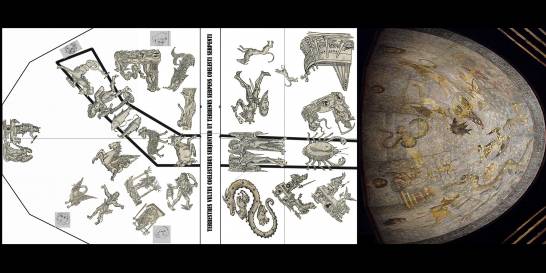One of the biggest enigmas kept by the University of Salamanca (USAL) seems to have been solved: the date that represents the Salamanca sky, the valuable pictorial mural in the vault of his library made by the Salamanca artist Fernando Gallego in the 15th century with the advice of astronomy professors.
The only astronomical event compatible with what is painted on the preserved fragment of the vault was the triple conjunction of Venus, Mars and Saturn in the sign of Cancer, visible in Salamanca from 13 to 15 August 1475.
Azucena Hernandez (UCM)
The work would represent the sky of August 13, 14 and 15, 1475 for the longitude and latitude of Salamanca, according to an investigation by the Complutense University of Madrid (UCM) carried out by Azucena Hernández.
“The representation of this celestial vault is an unprecedented pictorial work in Spanish art. It was a demonstration of erudition and an express recognition of the peculiarity of a space for study and reflective reading”, highlights the researcher.
In the mural, of which only a third of its surface is preserved by works in 1763, the twelve zodiacal signs crossed the surface of the vault in an oblique display. On either side of this zodiacal band, twelve boreal constellations and twelve southern constellations were represented, as well as the Sun, Moon and the five planets known in the 15th century.
Library of the University of Salamanca. /libraries.usal.es
Hernández managed to reconstruct the lost part of the work and reveals that the presence of planets confirmed the intention to represent the sky on an exact date: “We start from the hypothesis that the intellectual authors of the project, astronomers linked to the University of Salamanca, chose the representation of the visible celestial vault of Salamanca on a date associated with a singular astronomical event and not of political or social significance as previously assumed”.
To carry out the study, the researcher analyzed all astronomical events considered ‘singular’ in the Middle Ages (eclipses of the sun or moon, visibility of comets and planetary conjunctions) during an interval of 37 years, since the foundation of the chair of Astronomy in 1460 until the mention of work on the vault in the work By Hispaniae Laudibus from 1497.
The Sun and Mercury help in courtship
The positions of the Sun and Mercury served as a starting point for the study and made it possible to rule out incompatible astronomical events. The study was performed manually, reviewing the data of planetary positions, day by day, month by month and year by year during the analyzed period.
A museum recreation project of the complete vault is under way based on this research and with the collaboration of a painter specializing in historical recoveries.
“Finally, the only astronomical event compatible with what is depicted in the preserved fragment of the vault was the triple planetary conjunction of Venus, Mars and Saturn in the sign of Cancer, visible in Salamanca from August 13 to 15, 1475, precisely when the library was being built”, emphasizes Hernández.
“The work is so unique, unique in the world, that he has always regretted not knowing what it was like before its partial disappearance”, concludes the researcher, who advances the possibility of creating a complete replica: “The proposal interested so much the authorities of the University of Salamanca , as well as the city’s political leaders, and a museological recreation project of the complete vault is underway based on this research and with the collaboration of a painter specializing in historical recoveries”.
Rights: Creative Commons.
.
